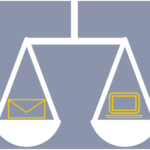![By Stamp owned by Swollib, and modified by me Jak. (http://en.wikipedia.org/wiki/Image:Wiki_usps.JPG) [Public domain], via Wikimedia Commons](https://www.diditdm.com/wp-content/uploads/2015/06/Wiki_usps.png)
June 29, 2015: Each day we read of marketing successes generated by the exclusive use of digital marketing channels, including SEO, social media, and paid online listings. And while there’s no doubt that an an “all digital” marketing plan can work, many marketers handicap themselves by ruling out more established marketing techniques, including the use of direct mail.
Several market mechanisms, however, are now interacting to make the use of direct mail more attractive. The first is the decline, on a macro level, in the total number of mail pieces distributed each year. The volume of Standard Mail (the classification of mail used to describe commercial mail) is dropping by more than 1 percent per year. In certain industry verticals, the decline may be much steeper. The USPS attributes this long-term secular decline to what it calls “digital diversion,” another way to describe the increased tendency of many established marketers to pull out of direct mail and allocate budget in the direction of digital channels. The result of such “diversion” is that getting attention in the physical mailbox is easier than it was five or ten years ago. This situation is the obverse of the situation in digital media right now, where pristine “organic” channels are quickly clogged with spam and irrelevancy as marketers crowd into the channel.
The second market mechanism is more subtle but just as real: the psychological burnout that many digital natives feel when confronted with the sheer volume of ads in their digital streams. The result is a flight away from advertising that’s expressed in many ways: in the increasing use of ad blockers, increasing adoption of niche social networks eschewing advertising, and perhaps, if Apple has its way, in the future selection of hardware platforms (Apple recently announced that it will allow developers to build ad-blocking extensions to its popular Safari browser).
The third mechanism is a function of the evolution of online advertising itself. Up until very recently, tracking consumer behavior online was dependent on an old and increasingly unreliable method using cookies. Today, however, a new method termed “Custom Audiences” bypasses cookie technology completely. Custom Audiences (invented by Facebook in 2012) is a simple, yet effective technology that makes use of e-mail lists as the campaign cornerstone. This method dovetails extremely well with the infrastructure of direct mail, which from time immemorial has used lists to power campiagns.
Direct mail – in the era of Facebook, Google, and Amazon – may seem to the digital marketing enthusiast to be a remnant of the past. There’s nothing “cool” about direct mail: no IPOs, APIs, or the kind of “hacker marketing culture” we find in SEO and social media.
At the same time, however, it’s clear that the digital marketing ecosystem has its share of problems, some of which can be alleviated by a smart use of postal mail. Bot traffic is rising (56% in 2014, according to anti-spam vendor LavaSoft). Ad viewability remains an issue. Response rates from e-mail remain in decline, thanks to the efforts of Gmail and other email providers’ to auto-route commercial emails to hidden areas behind the “promotional” tabs. Even content marketing – a sound strategy for many – remains an uphill battle in an environment in which the supply of content exceeds the supply of human readers.
No, postal direct mail isn’t cool. But even as its macro influence declines (standard mail volumes are declining at the rate of about 1% per year), it can still work. It’s a tried and true method that includes a way for you to know exactly who’s responding to each of your messages. Here are five reasons why you should invest some budget – even if it’s R&D chump change – in a tech-enabled direct mail campaign:
Direct mail gives you a true opt-in
New ad technologies are increasing the value of a true opt-in in the form of an e-mail address. Such an opt-in unlocks the power of custom audiences. Using direct mail to entice recipients to visit a custom URL (PURL) or activate an app through NFC or QR code is an excellent way to assemble lists of truly engaged customers. Integration of postal mail campaigns with marketing automation suites and standard analytics packages is easier than ever. The result is that you can use postal mail to qualify online audiences, finding those audience members who are most likely to become real paying customers.
The physical mailbox is becoming less crowded
As aggregate direct mail volume declines, there’s more opportunity for creative mail marketers to make noise. This situation is the obverse of the digital mailbox, which grows more crowded each year. As large incumbents move budgets away from direct mail, challengers will have more of a chance to stand out.
Pricing advantages
In May, 2015, the USPS raised Standard Mail prices by just under 2%. But it also announced a 2% discounts for users of its “Mail Drives Mobile Engagement” program. The Postal Service will offer a 2% discount on mailpieces that include mobile print technology and direct recipients to a mobile shopping experience. Additionally, the USPS’ Advanced and Emerging Technology promotion “aims to continue encouraging mailers to integrate direct mail with mobile technology or new advances in print.” This means mailings equipped with Near Field Communication (NFC) technology and AR (augmented reality) elements will receive favorable pricing treatment.
Millennials and digital natives like mail
Maybe it’s just the novelty factor or retro-cool, but young people rely on newspapers, fliers, catalogs, and printed matter for purchase-related information. A well designed mailer can cut through the digital noise, and the UK’s Royal Mail found evidence that physical mailers engage a different (and presumably more retentive) part of the brain.
Hyperlocality
The USPS’ new “Every Door Direct Mail” program provides an affordable way to “saturation bomb” distinct localities. EDDM campaigns, when combined with NFC, QR, and PURLs, provide an ideal way to identify locally engaged prospects and customers, drive them online, and track them across channels.
The Envelope is your creative canvas
Email subject lines in a cluttered inbox and display ad creative lost in a cluttered page aren’t that interesting in comparison with an envelope. Admit it, you take the time before even deciding to open an envelope to determine who it is from and guess to what’s inside. With Digital printing your creativity isn’t limited to what goes inside the envelope. You can personalize a whole lot more than just the address.
Appendability
When you mail to a postal list where you also have their digital touchpoints (CRM / email and Social CRM / Twitter, etc) you can increase the effectiveness of communications by referencing the postal mail they received. An orchestrated strategy beats an ad-hoc strategy.
Marketers with developed digital infrastructures can easily bolt on a direct mail component to their mix of channels. While direct mail isn’t a “shiny object” like the latest app or niche social network, being able to reach real people at real addresses and be able to track back real response can deliver real results. So if you’re not experimenting with direct postal mail, you may be missing out the chance to connect with customers in a powerful, authentic way.
B2B, where the value of a new relationship or incremental business tends to be quite high, can prove out significant ROI with a well executed direct mail plan, particularly one that also engages the prospects digitally.










![By Photograph: Frank C. Müller, Baden-Baden (Own work) [CC BY-SA 2.5 (http://creativecommons.org/licenses/by-sa/2.5)], via Wikimedia Commons](https://www.diditdm.com/wp-content/uploads/2015/08/opening-an-envelope-150x150.jpg)
![By User:Introvert (Own work) [CC BY-SA 2.5 (http://creativecommons.org/licenses/by-sa/2.5)], via Wikimedia Commons](https://www.diditdm.com/wp-content/uploads/2015/10/1024px-Sparkling-snow.sierra-150x150.jpg)